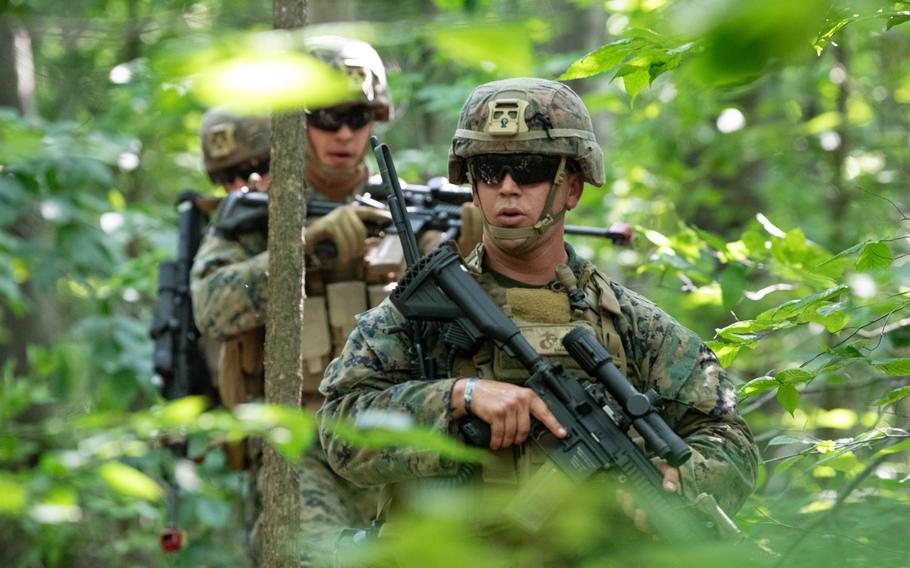
Marines with 1st Battalion, 24th Marine Regiment — a reserve infantry battalion located throughout Michigan, Ohio and Indiana, and nicknamed Terror from the North — train during the Northern Strike military exercise at Camp Grayling, Mich., Aug. 8, 2025. (Phillip Walter Wellman/Stars and Stripes)
CAMP GRAYLING, Michigan — The rigid-hulled inflatable patrol boat lurched into Lake Huron as three Army Special Forces soldiers and a Michigan State Police officer leaned over the edge, pulling supplies out of the water.
A helicopter had dropped packages into the lake during Northern Strike, the annual military exercise in northern Michigan sponsored by the National Guard Bureau and attended by nearly every U.S. military service.
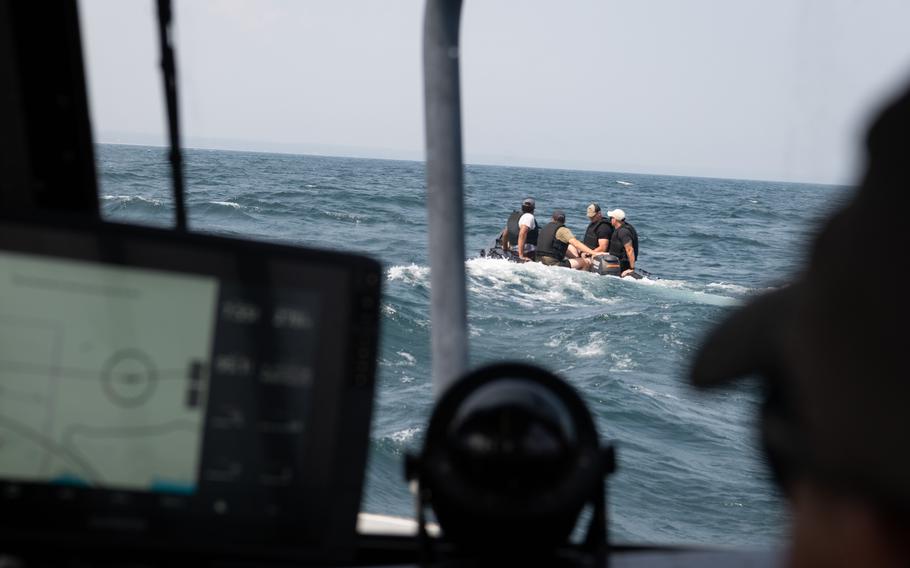
Special Forces soldiers with the Army National Guard participate in a maritime exercise on Lake Huron, off the coast of Rogers City, Mich., Aug. 6, 2025. It was part of the Northern Strike, one of the Defense Department’s largest reserve component exercises. (Phillip Walter Wellman/Stars and Stripes)
The team’s task: to retrieve the supplies and pass them to another group of soldiers in a smaller boat to take ashore — a skill organizers say could one day prove valuable in the Indo-Pacific.
For the first time in its decade-plus history, this year’s Northern Strike, which wrapped up Saturday, shifted from its traditional European scenario to a simulated Indo-Pacific backdrop, reflecting the Pentagon’s growing focus on conflict in that region.
Adding to the significance was the inclusion of hundreds of troops from Taiwan, a U.S. partner that China claims as its own and that American defense officials view as the most likely flashpoint for a potential war in Asia.
In a briefing attended by Stars and Stripes on Aug. 4, a senior Michigan National Guard official said that more than 500 Taiwanese troops participated in Northern Strike this year. A briefing slide indicated that Taiwan has been quietly sending its forces to the exercise since at least 2021.
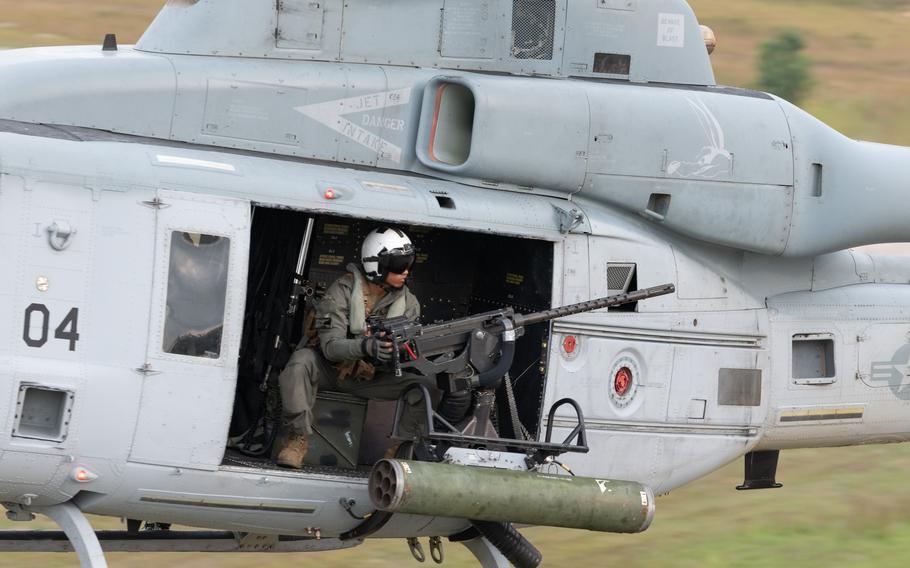
Cpl. Elijah Morales, a UH-1Y Venom Huey crew chief with Marine Light Attack Helicopter Squadron 775, out of Marine Corps Air Station Camp Pendleton, Calif., mans a GAU-21 .50 caliber machine gun mid-flight, during close air supporting training, part of the Northern Strike military exercise in northern Michigan, Aug. 6, 2025. (Phillip Walter Wellman/Stars and Stripes)
As a matter of long-standing policy, the Pentagon doesn’t discuss Taiwan’s participation in U.S. exercises, a defense official there said when asked for further details by Stars and Stripes.
But in 2024, former U.S. diplomat Joseph Cella confirmed during testimony at a House hearing on the Chinese Communist Party that Taiwanese troops had been training “in strategic and tactical battle operations” in Michigan.
Northern Strike will be organized around an Indo-Pacific scenario indefinitely, said Brig. Gen. Ravi Wagh, assistant to the adjutant general-Army for the Michigan National Guard.
It’s part of a push to make Michigan a premier location to prepare forces for potential large-scale combat in the Asian theater.
“As we’ve seen the national priority shift … we need to align and plan for that region,” Wagh said.
Northern Strike’s land exercise director, Col. Todd Fitzpatrick, pointed to the state’s geography as a reason it’s especially well-suited for Indo-Pacific training.
“We’re right smack in the middle of the Great Lakes, so we are able to replicate that island environment,” Fitzpatrick said.
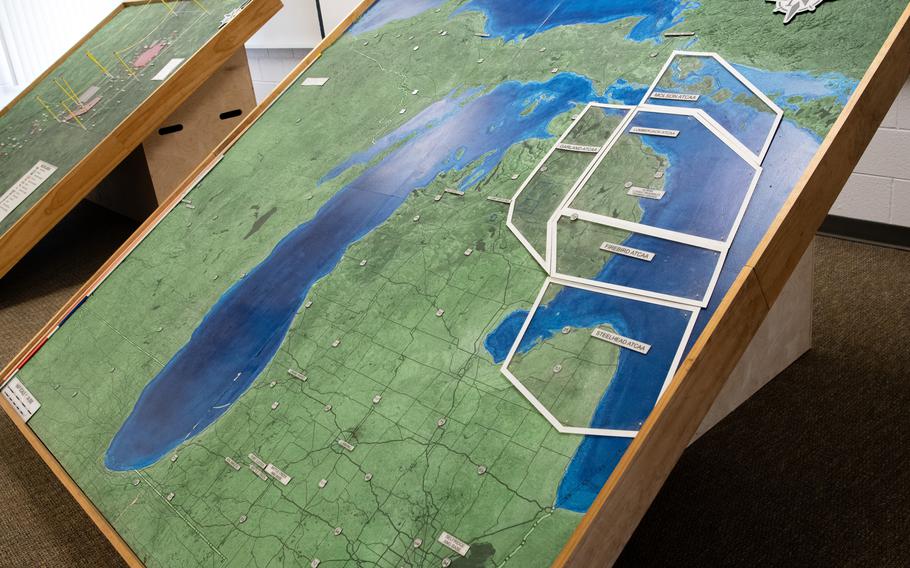
A map of Michigan at Camp Grayling shows the airspace over land and water during the Northern Strike military exercise this month. (Phillip Walter Wellman/Stars and Stripes)
In a conflict with China, analysts say, U.S. forces would likely have to disperse across small islands and operate stealthily, given Beijing’s missile capabilities, which make large bases vulnerable.
This year’s exercise placed greater emphasis on maritime drills, a focus planners say will expand in future editions. To support that shift, the Michigan National Guard is buying several Mark VI patrol boats. For now, they relied on Michigan State Police boats and crews for many water drills.
A Special Forces soldier aboard one of the boats, who was in Michigan for the first time, said he was struck by the vastness of the lake, which stretches to the horizon in every direction if you’re out far enough.
Stars and Stripes agreed to withhold the identities of the Special Forces team for security reasons.
“The world is forever changing, and we want to remain relevant,” another member said of their participation in the drill.
The soldiers, who normally don’t work on the water, received training on delivering supplies to troops on an island, a challenge very different from those faced in Europe, where supplies move overland, or the Middle East, where the U.S. relies on large bases.
“We’re plussing ourselves up to ensure we have the capabilities to be able to retrieve cargo and get it back to our troops or whomever it is that we’re supporting,” the second soldier added. “That way, later down the road, we can just ease into it naturally.”
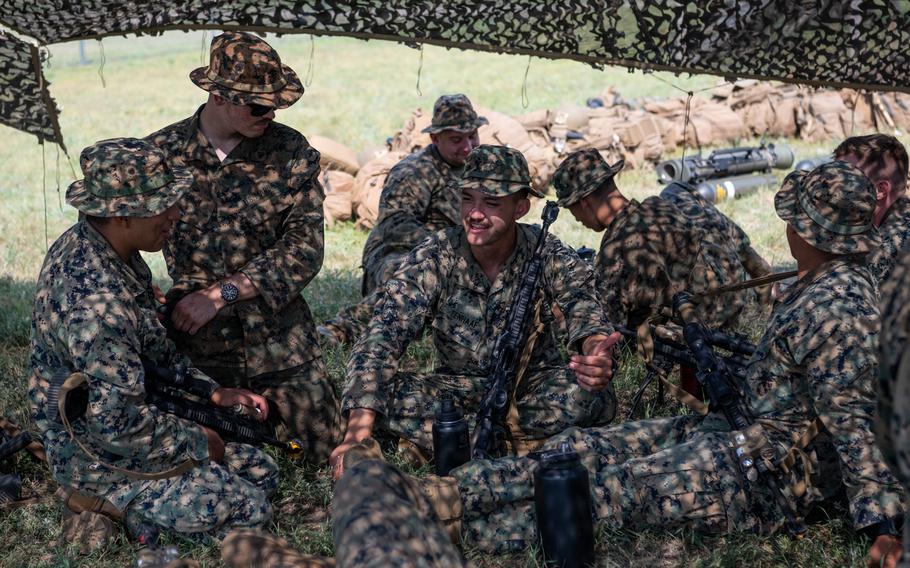
Marines with 1st Battalion, 24th Marine Regiment, rest in the shade after establishing a base camp at Camp Grayling, Mich., during the Northern Strike military exercise, Aug. 7, 2025. (Phillip Walter Wellman/Stars and Stripes)
Northern Strike is one of only a few National Guard Bureau-sponsored exercises accredited by the Pentagon’s Joint National Training Capability program, which requires multiple branches of the military to operate together in a realistic environment.
That matters because if war were to break out against a powerful adversary like China, all branches would need to operate seamlessly.
More than 7,500 participants from 36 states and territories, every branch of the military except the Space Force, and nine international partners took part in this year’s exercise.
Northern Strike also has a smaller winter portion that focuses on cold-weather operations and joint artillery fire. It simulates a small clash escalating into the larger summer scenario.
The integration of Guard and reserve units with active-duty forces in a JNTC-accredited environment is another key feature that sets the exercise apart.
Guard and reserve forces, which conduct most of their training in the United States, would likely be mobilized for a large-scale conflict in Asia.
Another factor that makes Michigan a preferred training ground is its 17,000 square miles of military airspace. It’s the largest block of such space east of the Mississippi River and high enough to accommodate fifth-generation fighter jets.
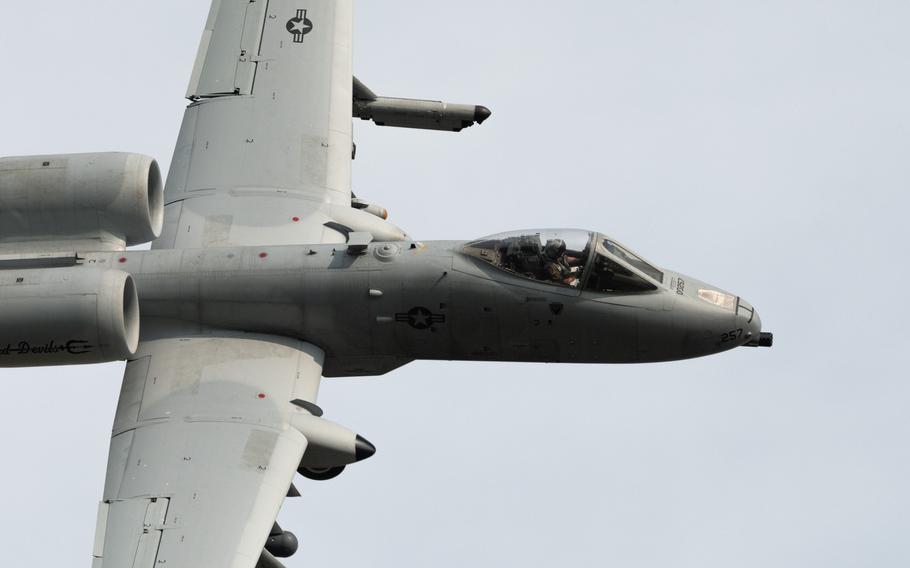
An airman with the 127th Wing based at Selfridge Air National Guard Base, Mich., flies an A-10 Thunderbolt II aircraft above the Steel Gate air-to-ground range, part of Camp Grayling, Mich., on Aug. 6, 2025, during the biannual Northern Strike military exercise. (Phillip Walter Wellman/Stars and Stripes)
Unlike similar ranges in the western U.S., Michigan’s airspace allows for live targeting in the water.
The Alpena Combat Readiness Training Center manages that airspace, along with additional sites that include a littoral area at the Rogers City Calcite Quarry, the world’s largest limestone quarry.
About 100 miles to the west, Camp Grayling — the largest National Guard training facility in the country — adds nearly 150,000 acres for live fire, an air-to-ground range and a two-runway Army airfield.
Together, Alpena and Grayling make up Michigan’s All-Domain Warfighting Center, which was bustling with troops training across land, air and maritime domains throughout the two-week exercise.
“We have different locations around the state that we can send troops to, and they can set up tents and operate in an expeditionary manner and kind of simulate that island mentality,” said Col. Ross Evenhouse, director of operations for the Michigan Air National Guard, who oversaw the air portion of the exercise.
Members of the Missouri-based 131st Bomb Wing, the only nuclear-equipped National Guard unit, camped out at Oscoda-Wurtsmith Airport, a former Air Force base some 50 miles south of Alpena that housed nuclear-armed B-52 Stratofortress bombers during the Cold War and now functions as a public airport.
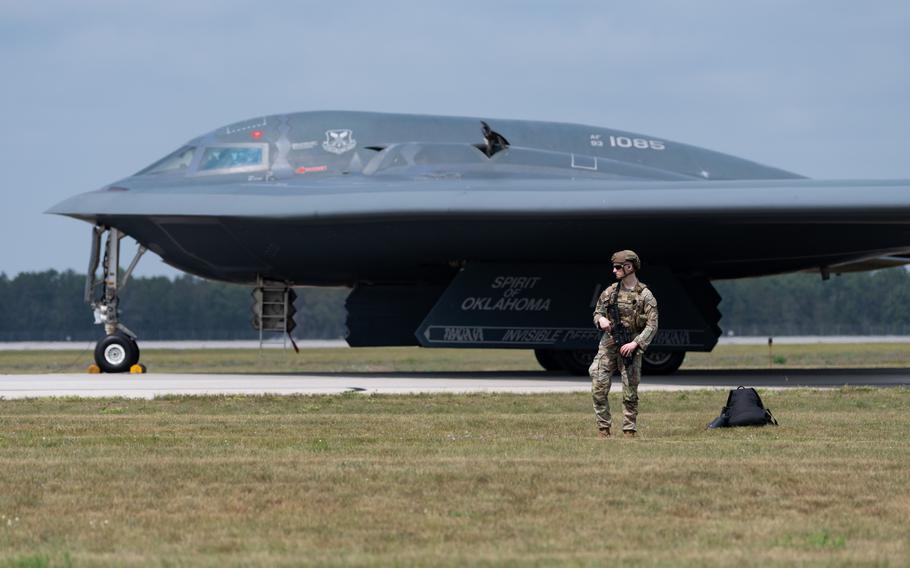
Airman 1st Class Timothy Cadigan, assigned to the 509th Security Forces Squadron out of Whiteman Air Force Base, Mo., guards a B-2 Spirt stealth bomber in Oscoda, Mich., during a rare aircrew changeover outside the aircraft’s home base, Aug. 5, 2025. It was part of the Northern Strike military exercise and marked the first time a B-2, the Air Force’s premier strategic, long-range heavy bomber, landed in Michigan. (Phillip Walter Wellman/Stars and Stripes)
The unit’s primary mission is flying the B-2 Spirit stealth bomber, which typically takes off from Whiteman Air Force Base, conducts its mission and returns without ever landing, thanks to midair refueling. That was the case in June, when B-2s struck Iranian nuclear facilities.
On Aug. 5, two of the aircraft landed in Michigan for the first time during Northern Strike, practicing an aircrew changeover. Maintainers and base defense airmen from the unit supported the operation, which drew attention from nearby residents watching from the fence line.
“We’re practicing for the future of warfare,” said 2nd Lt. Chris Bishop, a spokesman with the 131st Bomb Wing, who was camping at the site. “We’re practicing not having everything that we’re used to having. We’re setting up tents, purifying our own water, practicing different scenarios with limited communications equipment.”
B-2 maintainer Senior Airman Antonio Corona said the operations tempo sets Northern Strike apart from training at Whiteman.
“We’ve had to be in and out, moving, making sure everything’s right, making sure everyone’s set,” Corona said. “It’s been a good experience.”
A few days later, on Aug. 9, an Air Force C-130 Hercules assigned to the Mississippi-based 815th Airlift Squadron made a first-of-its-kind landing on a section of repaired runway at the Alpena base.
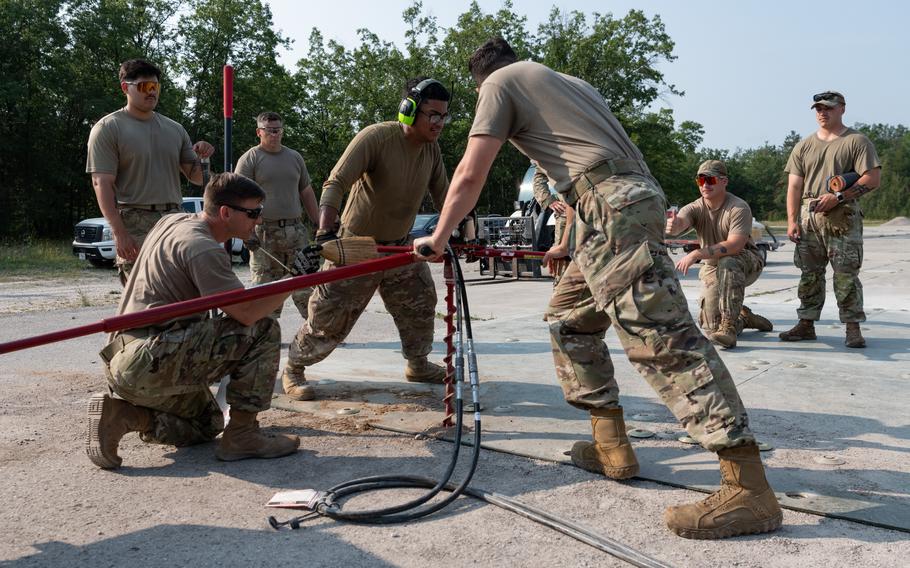
Airmen assigned to the 23rd Combat Air Base Squadron practice fixing a damaged runway in Aplena, Mich., on Aug. 5, 2025, during the two-week Northern Strike military exercise. On Aug. 9, a U.S. Air Force C-130 Hercules assigned to the Mississippi-based 815th Airlift Squadron made a first-of-its-kind landing on a repaired section of runway at the Alpena Combat Readiness Training Center. (Phillip Walter Wellman/Stars and Stripes)
The runway had been purposely destroyed, as if it had been hit by an enemy missile. Airmen assigned to the 23rd Air Task Force had to repair it with fiber-reinforced plastic matting, a relatively new, lightweight, high-strength surface system for rapid repair.
Since Vietnam, the Air Force has used aluminum matting. Fiber-reinforced plastic resists corrosion, making it better-suited for dispersed island bases in the Indo-Pacific.
Prior to Northern Strike, airmen had not installed matting of that type and then tested it with Air Force aircraft, according to Maj. Anthony Hylko, base civil engineer for the Alpena CRTC.
“It is a true wartime skill set that we need to ensure we are honed in and ready to execute in a contingency environment, and we’re doing that here,” Hylko said.
China is taking note of the training in Michigan, according to the Michigan National Guard official who spoke at the Aug. 4 briefing.
In August 2023, five Chinese nationals studying at the University of Michigan were caught on Camp Grayling after midnight taking pictures near military vehicles and communications equipment.
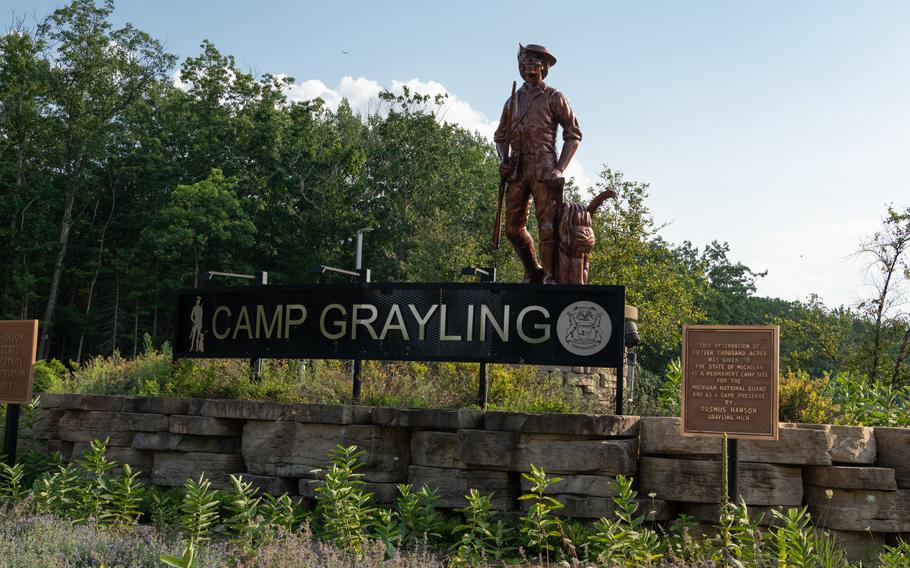
The main entrance to Camp Grayling, Mich., on Aug. 8, 2025. (Phillip Walter Wellman/Stars and Stripes)
They fled when confronted and later were charged by federal prosecutors with conspiracy and lying to investigators. Arrest warrants remain outstanding.
Back in his office at Camp Grayling, Wagh said that while Northern Strike prepares troops for potential conflict in Asia, its larger purpose is to prevent one by showcasing U.S. joint operations and the military’s ability to scale up.
“I believe in deterrence, and I believe the best way to create deterrence is by lethal-capable formations,” Wagh said. “And I think we’ve got something here that creates lethal-capable formations in the joint force.”